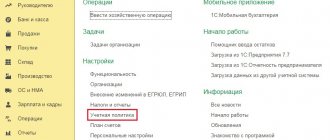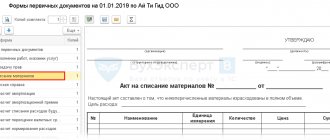The declaration is filled out in the following sequence: first, the appendices to the declaration are filled out, corresponding to the transactions that the taxpayer had during the reporting period. Then section 2 is formed, and then section 1 is filled out based on this data.
The lines “TIN” and “KPP” in each section of the declaration are filled in automatically from the client’s registration card in the “SBIS” system. The page serial number is also indicated automatically.
- Title page
- Section 1. Amount of excise duty on excisable goods subject to payment to the budget
- Section 2. Calculation of the amount of excise duty on excisable goods
- Subsection 2.1. Operations carried out with excisable goods, with the exception of operations for sale outside the territory of the Russian Federation
- Subsection 2.2. Operations for the sale of excisable goods outside the territory of the Russian Federation, including on the territory of member states of the Eurasian Economic Union
- Subsection 2.3. Amount of excise tax to be deducted
- Subsection 2.4. The amount of excise tax payable to the budget or accrued for reduction
- Subsection 2.5. Documented fact of sale of excisable goods outside the territory of the Russian Federation
- Appendix 1. Calculation of the amount of excise tax on cigarettes (cigarettes)
- Appendix 2. Sales of excisable goods outside the territory of the Russian Federation, for which an exemption from excise duty was applied during the tax period upon presentation of a bank guarantee or surety agreement
Title page
On the title page, the taxpayer fills in all the details, except for the section “To be filled out by a tax authority employee .
When filling out the “Adjustment number” , “0” is automatically entered in the primary declaration; in the updated one for the corresponding period, you must indicate the adjustment number (for example, “1”, “2”, etc.).
In the “Tax period” , the calendar year for which the tax period is being submitted is indicated, and the reporting month code is selected from the corresponding directory. For example, when submitting a report for August, the code “08” is indicated, for September – “09”, etc.
When filling out the “Submitted to the tax authority” , the full name of the tax authority to which the declaration is submitted is reflected. This line is filled in automatically when you select a tax authority code from the appropriate directory. By default, the program enters the code and name of the tax authority specified in the taxpayer registration card.
In the field “at location (accounting)”, select the code for the place of submission of the declaration: at the location of the Russian organization - “214”, at the place of residence of the individual entrepreneur - “120”, etc.
The “taxpayer” field reflects the full (without abbreviations) name of the organization (or branch of a foreign organization) in accordance with the constituent documents, and in the case of submitting an individual entrepreneur’s declaration, his full last name, first name, patronymic (if any) are indicated in accordance with identity documents .
The fields “Form of reorganization (liquidation)” and “TIN/KPP of the reorganized organization” are filled in only by those organizations that are reorganized or liquidated during the reporting period.
“Contact telephone number” field automatically reflects the taxpayer’s telephone number specified during registration.
When filling out the field “On ____ pages”, indicate the number of pages on which the declaration is drawn up. The field value is filled in automatically and recalculated when the composition of the declaration changes (adding/deleting sections).
The field “with supporting documents or their copies on ___ sheets” reflects the number of sheets of supporting documents and (or) their copies (if any). Such documents may be: the original (or a certified copy) of a power of attorney confirming the authority of the taxpayer’s representative (if the declaration is submitted by the taxpayer’s representative), etc.
In the section of the title page “I confirm the accuracy and completeness of the information:” the following is indicated:
- 1 - if the report is submitted by the taxpayer,
- 2 - if the declaration is submitted by a legal or authorized representative of the taxpayer.
In this case, the full name of the head of the organization or representative is indicated, as well as the name and details of the document confirming his authority.
Also in this section of the declaration the date is automatically indicated.
Procedure for paying excise tax
Contributions to the budget from nicotine products are paid by manufacturers, importers and distributors. Each taxpayer generates a tax return based on the quantity of goods handled during the reporting month. Payment must be made by the 25th of the next month. For manufacturers at the place of production of products.
The manufacturer pays tax based on the fact of transfer of products to another division or sale to a retail chain. Reports to the tax authority every month on transactions carried out with excisable tobacco products.
The importer carries out an excisable transaction of importing tobacco and the customs declaration is a report on the date of the transaction. This reporting act contains information about the quantity of excise goods on which tax is paid. If transactions occur monthly, the excise tax is paid every month. In one payment, because advance excise payments are not established for the importer.
For tobacco sellers, the reporting system includes an act of acceptance and transfer of tobacco products. Based on this, the distributor calculates the excise duty on a monthly basis. The seller purchases nicotine products from manufacturers or importers. Pays the tax, observing the accepted deadline, until the 25th of the next month.
Section 1. Amount of excise duty on excisable goods subject to payment to the budget
Section 1 is completed after the remaining sections and annexes of the declaration are completed.
Line 010 indicates the code of the municipality in whose territory the excise tax is paid. This code is selected from the corresponding directory. You can find out your OKTMO code using the electronic services of the Federal Tax Service “Find out OK” (https://nalog.ru, section “All services”).
Line 020 reflects the budget classification code to which the excise tax on tobacco products is credited.
Line 030 indicates the amount of excise tax payable to the budget. In this case, the value of line 030 must correspond to the amount of excise tax indicated under code 40001 in subsection 2.4.
Line 040 indicates the amount of excise tax accrued for reduction (the amount of excess tax deductions over the calculated amount of excise tax). The value on page 040 must coincide with the amount of excise tax under code 40002 in subsection 2.4.
If several amounts of excise taxes calculated for different types of goods are to be credited to the same BCC, then they must be added up and the final result must be indicated in lines 030 - 040 .
Administrative and criminal liability for the sale of cigarettes without excise tax
When selling tobacco products subject to labeling without excise stamps (including its production, as well as in violation of the established procedure for labeling and/or applying information), there are 2 types of liability:
- administrative (if the sales of tobacco products are not considered large);
- criminal (if the offense was committed by an organized group, on a large or especially large scale).
To classify the size of sales of unlabeled tobacco products, Art. 169 of the Criminal Code of the Russian Federation, which defines 2 concepts:
- large size - the cost of unlabeled tobacco products exceeds 100,000 rubles;
- especially large size - product cost exceeds 1 million rubles.
The general scheme of liability for the sale of tobacco products without excise stamps is given below.
Criminal liability for the sale of cigarettes without excise stamps (if such an obligation is determined by law) occurs if:
- the intention of the perpetrator for the subsequent sale of tobacco products has been established or the fact of their sale has been confirmed;
- the large size of tobacco products has been proven.
You will be introduced to the types of responsibilities for taxpayers and individuals by materials prepared by specialists on our website:
- “Both the employer and the employee will be punished for “gray” wages”;
- “The Ministry of Finance recalled the conditions for a fine under Art. 123 Tax Code of the Russian Federation" ;
- “Fines for 6-personal income tax: the Federal Tax Service explains the rules for imposition”.
Section 2. Calculation of the amount of excise duty on excisable goods
Section 2 is intended to calculate the amount of excise tax in relation to each code of the type of tobacco product separately.
Lines 010 - 030 are filled in only for such types of tobacco products as: cigarettes, cigarettes, cigarillos, bidis and kreteks (codes 440, 450 and 460) for tax periods from September 1 to December 31 of each year. If the declaration is submitted for other tax periods or for other types of tobacco products, then lines 010 - 030 are not filled in.
Line 010 indicates the total volume of excisable goods sold during the tax period.
Line 020 indicates the average monthly total volume of goods sold in the previous calendar year, which is determined by dividing the total volume of sales of these goods for the year by 12.
Line 025 reflects the volume of tobacco products sold during the tax period and imported into the territory of the Russian Federation.
Line 030 indicates the value of the T coefficient, which is calculated as follows:
- if page 010 > page 020
page 030 = 1 + 0.3 * (page 010 – page 020) / page 010;
- in other cases, the coefficient T ( p. 030 ) is taken equal to 1.
Coefficient T is also assumed to be equal to 1 for persons who became taxpayers for the first time in relation to cigarettes, cigarettes, cigarillos, bidis and kreteks in the calendar year of the current tax period or in the year preceding the year of the current tax period.
Using line 040 from the directory, select the code for the type of excisable product, for which subsections 2.1 - 2.5 are filled out separately.
Excise tax: legislative framework
The list of excisable goods, conditions and procedure for payment of excise duty are approved by Chapter 22 of the Tax Code of the Russian Federation:
| No. | Regulatory document regulating the procedure for paying excise duty | Description |
| 1 | Art. 179 Tax Code of the Russian Federation | Article of the Tax Code defines the circle of excise duty payers , who are recognized as legal entities and entrepreneurs performing excise transactions. |
| 2 | Art. 181 Tax Code of the Russian Federation | This provision of the Tax Code contains complete list of excisable goods:
|
| 3 | Art. 182 Tax Code of the Russian Federation | The Tax Code article states list of excise transactions, among which:
|
The reporting period for the calculation and payment of excise duty is a calendar month. The excise duty is payable no later than the 25th day of the month following the reporting period (month) during which the excisable goods were shipped for sale (based on the transfer and acceptance certificate).
Subsection 2.3. Amount of excise tax to be deducted
Subsection 2.3 is intended for taxpayers eligible to apply for tax deductions.
This subsection reflects the following information:
- in column 1 - transaction codes 30001 and 30002 ;
- in column 2 - the volume of goods in physical terms, the amount of excise duty on which is subject to tax deduction;
In relation to cigarettes and cigarettes (codes 450 and 460), the volume must coincide with the value of page 040 of Appendix 1 for the corresponding codes of the type of product and transactions reflected in pages 010 - 020 of Appendix 1, i.e.:
gr. 2 = page 040 adj. 1 if page 040 sec. 2 = 450, 460 , page 040 sec. 2 = page 010 adj. 1, gr. 1 subsection 2.3 = page 020 adj. 1
- in column 3 - the amount of excise tax to be deducted.
For cigarettes and cigarettes (codes 450 and 460), the amount of excise tax should be equal to the value of page 030 of Appendix 1 for the corresponding codes of the type of product and transactions reflected in pages 010 - 020 of Appendix 1, i.e.:
gr. 3 = page 030 adj. 1 if page 040 sec. 2 = 450, 460 , page 040 sec. 2 = page 010 adj. 1, gr. 1 subsection 2.3 = page 020 adj. 1
Excise tax rates
After determining the moment of accrual of excise duty, determine the excise tax rate on the sold (transferred) product. This is due to the fact that the procedure for determining the tax base depends on the type of tax rates established for various excisable goods.
Tax legislation provides for three types of excise tax rates:
- hard or specific - in rubles per unit of measurement of the volume of excisable goods sold (transferred);
- ad valorem - as a percentage of the price (cost) of sold (transferred) excisable goods;
- combined - simultaneously including both fixed and ad valorem tax rates.
Currently, only two types of tax rates apply:
- combined – established for cigarettes and cigarettes;
- solid or specific - established for other excisable goods.
This conclusion follows from the provisions of paragraph 2 of Article 187 and Article 193 of the Tax Code of the Russian Federation.
The excise tax rate is determined based on the provisions of Article 193 of the Tax Code of the Russian Federation.
Situation: at what rate should the excise tax be charged on the sale of carbonated wine products with a volume fraction of ethyl alcohol over 8.5 percent?
When selling carbonated wine products, charge excise tax at the rate established for sparkling (champagne) wines.
This is explained as follows.
According to the All-Russian Classification of Products (OKP), wine products with a volume fraction of ethyl alcohol over 8.5 percent are carbonated wine (OKP code 15.93.11.210). That is, wine with a volume fraction of ethyl alcohol from 8.5 to 12.5 percent, obtained by artificially saturating table wine material with carbon dioxide. In turn, carbonated wines (code 15.93.11.210) are included in group 15.93.11 “Sparkling and carbonated wines.” Even if carbonated wine products are made on the basis of fruit wines, they cannot be classified as fermented drinks (code 15.94.10).
For alcoholic products, the excise tax rates established in Article 193 of the Tax Code of the Russian Federation are applied. There is no separate excise tax rate for carbonated wines. However, based on the grouping of alcoholic beverages presented in the All-Russian Classification of Products, for the purpose of calculating excise taxes, carbonated wines should be classified as sparkling wines (champagne).
Thus, when selling carbonated wine products with a volume fraction of ethyl alcohol over 8.5 percent, apply an excise tax rate of 26 rubles. for 1 l.
Subsection 2.4. The amount of excise tax payable to the budget or accrued for reduction
The indicators of subsection 2.4 are calculated automatically based on data from subsections 2.1 -2.3:
| Indicator name | Filling procedure |
| Indicator code (column 1) | - code 40001 - Amount of excise tax payable to the budget - code 40002 - Amount of excess of tax deductions over the calculated amount of excise tax |
| Excise tax amount (column 2) | gr. 2 code 40001 = ∑ gr. 4 subsections 2.1 + ∑ gr. 4 subsections 2.2 by codes: 20003 - 20005, 20007, 20009, 20011, 20013, 20015 - ∑ gr. 3 subsections 2.3, if gr. 2 > 0 gr. 2 code 40002 = ∑ gr. 4 subsections 2.1 + ∑ gr. 4 subsections 2.2 by codes: 20003 - 20005, 20007, 20009, 20011, 20013, 20015 - ∑ gr. 3 subsections 2.3, if gr. 2 |
The amount of excise tax reflected under code 40001 is transferred (according to the corresponding BCC) to line 030 , and the amount under code 40002 is transferred to line 040 of section 1.
General procedure for calculating excise tax
Once the tax base is determined, calculate the amount of excise tax.
When selling (transferring) excisable goods for which a fixed rate is established, calculate the excise tax using the formula:
| Excise tax amount (fixed rate) | = | Volume of goods sold (in units of measurement specified in the excise tax rate) | × | Excise tax rate per unit of excise tax measurement |
This procedure is provided for in paragraph 1 of Article 194 of the Tax Code of the Russian Federation.
An example of excise tax calculation for the sale of excisable goods for which fixed excise tax rates are established
Alpha LLC is engaged in the production of alcoholic beverages with a volume fraction of ethyl alcohol of more than 9 percent.
The excise tax rate for alcoholic products with a volume fraction of ethyl alcohol of more than 9 percent is set at 500 rubles. for 1 liter of anhydrous ethyl alcohol contained in excisable goods.
In June, Alpha purchased 200 liters of anhydrous ethyl alcohol for use in production at a cost of 11,800 rubles. (including VAT - 1800 rubles) Previously (in May), the organization transferred to the budget an advance payment of excise tax for purchased alcohol (clause 6 of Article 204 of the Tax Code of the Russian Federation). The amount of the advance payment was 100,000 rubles. (200 l × 500 rubles) (paragraph 5, paragraph 8, article 194 of the Tax Code of the Russian Federation).
Alpha uses the purchased alcohol to produce liqueur with a volume fraction of ethyl alcohol of 14 percent. In June, Alpha produced 2,000 0.7-liter bottles of liqueur. The volume of alcohol used was: 2000 bottles. × 0.7 l × 14% = 196 l.
In July, the finished products were fully sold. The contract price of goods sold is 180,000 rubles. (including VAT - 18% and excise tax).
When calculating the excise tax, the Alpha accountant does not rely on the volume of alcoholic beverages sold, but on the amount of anhydrous ethyl alcohol contained in it.
The amount of excise tax for July will be equal to: 2000 bottles. × 0.7 l × 14% × 500 rub./l = 98,000 rub.
Alpha's accountant made the following entries in accounting (transactions related to the production of finished products are not considered).
In May:
Debit 68 subaccount “Calculations for advance payments of excise duty” Credit 51 – 100,000 rubles. – advance payment of excise tax is transferred (before purchasing alcohol).
In June:
Debit 10 Credit 60 – 10,000 rub. – alcohol is credited;
Debit 19 Credit 60 – 1800 rub. – VAT presented by the alcohol supplier is reflected;
Debit 68 subaccount “Calculations for VAT” Credit 19 – 1800 rub. – accepted for deduction of VAT on alcohol.
In July:
Debit 62 Credit 90-1 – 180,000 rub. – revenue from the sale of liquor is reflected;
Debit 90-3 Credit 68 subaccount “VAT calculations” – 27,457.63 rubles. (RUB 180,000 × 18/118) – VAT is charged on sales proceeds;
Debit 90-4 subaccount “Excise taxes” Credit 68 subaccount “Calculations for excise taxes” - 98,000 rubles. – excise tax is charged on the sale of liquor;
Debit 68 subaccount “Calculations for excise taxes” Credit 68 subaccount “Calculations for advance payments of excise taxes” - 98,000 rubles. – advance payment of excise tax is credited.
The amount of the advance payment of excise tax on alcohol within the amount of excise tax accrued on sold products is accepted by Alpha for deduction (clause 16 of Article 200 of the Tax Code of the Russian Federation). Since the advance payment exceeds the amount of excise tax accrued upon sale, at the end of July Alfa does not pay excise tax to the budget.
The remaining part of the advance payment of excise tax, not accepted for deduction in July (2,000 rubles = 100,000 rubles - 98,000 rubles), will be accepted by the Alpha accountant for deduction in subsequent tax periods in which the purchased ethyl alcohol will be used for the production of liquor - vodka products with a volume fraction of ethyl alcohol of more than 9 percent.
Appendix 1. Calculation of the amount of excise tax on cigarettes (cigarettes)
Appendix 1 is intended to reflect all transactions involving cigarettes and cigarettes completed during the tax period.
This application is completed separately for each type of excisable goods and transaction code in the aggregate. In this case, the data is indicated using the following codes: 10001, 10006 — 10012, 20001 — 20015, 30001, 30002, 50001 — 50011 .
Line 010 indicates the code of the excisable product: 450 or 460.
Using line 020, the operation code is selected from the corresponding directory.
Line 025 indicates the tax period code and year in which the goods were sold outside the territory of the Russian Federation.
Line 025 is filled in only for transactions with codes 50001 - 50011 .
Line 030 automatically calculates the amount of excise tax, calculated in aggregate by type of product and transaction code:
page 030 = page 150 + page 151
If codes 50001 - 50011 line 020, the amount of excise tax on line 030 is calculated in aggregate by type of product and transaction code, taking into account the tax period in which the goods were sold outside Russia.
Line 040 indicates the total volume of cigarettes or cigarettes (for all brands) sold in the tax period, which is calculated as follows:
page 040 = ∑ page 080
In the section “Amount of excise duty by brand (name) of cigarettes (cigarettes)” of Appendix 1, the following information is indicated in relation to each brand of cigarettes or cigarettes:
- on line 050 - brand of tobacco product;
- on line 060 - the number of packs sold (transferred) in the tax period;
- on line 070 - the number of tobacco products in one pack. If one brand has packs with different numbers of cigarettes or cigarettes, then this section is filled out for each packaging option;
- on line 080 - the volume of tobacco products sold (cigarettes or cigarettes), which is calculated as follows:
page 080 = page 060 * page 070 / 1000
- on line 090 - the amount of excise tax calculated based on the fixed tax rate and the volume of tobacco products sold, reflected on line 080 ;
- on line 100 - the maximum retail price per pack established by the taxpayer. Information on maximum retail prices specified in notifications received by tax (customs) authorities from tobacco product manufacturers is publicly available and published on the website: https://service.nalog.ru/tabak.do;
- on line 110 – the estimated cost of tobacco products sold, which is determined as follows:
page 110 = page 060 * page 100
- on line 120 - the amount of excise tax calculated on the basis of the ad valorem tax rate and the estimated cost indicated in line 110 ;
- on line 130 - the amount of excise tax calculated at the combined rate:
page 130 = page 090 + page 120
- on line 140 - the amount of excise tax, calculated based on the minimum excise tax rate on cigarettes or cigarettes and the volume of tobacco products sold, reflected on line 080 ;
- on lines 150 - 151 - excise tax amounts accepted for calculation to determine the excise tax payable to the budget:
page 150 = page 130 if page 130 > page 140 page 151 = page 140 if page 130
Excise goods of tobacco products
The tax does not only apply to filter cigarettes. The excise duty applies to types of tobacco, electronic smoking devices and smoking liquids. Tobacco for which tax is paid:
- Snuff.
- Chewing.
- Tubular.
- Smoking.
- Hookah bar.
- Cigarette.
- For cigarettes (with and without filter).
Manufacturers buy excise stamps for tobacco products at the stage of sales to retail chains. Tobacco as a raw material is not subject to tax burden. Electronic devices for permanent use and disposable items, together with nicotine liquids, have been subject to the law since 2022. At the moment when they began to be popular among smokers and young people.
The tax is established to replenish the budget from products sold that are not included in the list of necessary items for human life. Nicotine ruins people's health, and this fact is taken into account when determining government contributions. An indirect tax helps track the volume of nicotine products sold and observe annual sales dynamics.







